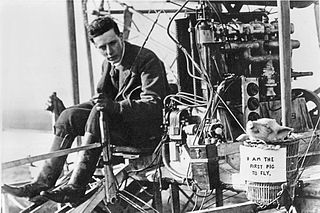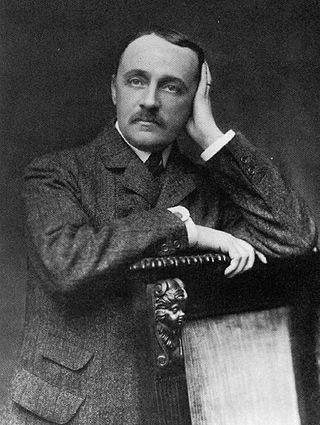This is a list of aviation-related events from 1902:
This is a list of aviation-related events from 1902:

An aircraft is a vehicle that is able to fly by gaining support from the air. It counters the force of gravity by using either static lift or the dynamic lift of an airfoil, or, in a few cases, direct downward thrust from its engines. Common examples of aircraft include airplanes, helicopters, airships, gliders, paramotors, and hot air balloons.

An airship is a type of aerostat or lighter-than-air aircraft that can navigate through the air flying under its own power. Aerostats use buoyancy from a lifting gas that is less dense than the surrounding air to achieve the lift needed to stay airborne.

Alberto Santos-Dumont, self-stylised as Alberto Santos=Dumont, was a Brazilian aeronaut, sportsman, inventor, and one of the few people to have contributed significantly to the early development of both lighter-than-air and heavier-than-air aircraft. The heir of a wealthy family of coffee producers, he dedicated himself to aeronautical study and experimentation in Paris, where he spent most of his adult life. He designed, built, and flew the first powered airships and won the Deutsch prize in 1901, when he flew around the Eiffel Tower in his airship No. 6, becoming one of the most famous people in the world in the early 20th century.

The history of aviation extends for more than 2000 years, from the earliest forms of aviation such as kites and attempts at tower jumping to supersonic and hypersonic flight by powered, heavier-than-air jets. Kite flying in China dates back to several hundred years BC and is thought to be the earliest example of man-made flight. Leonardo da Vinci's 15th-century dream of flight found expression in several rational designs, but which relied on poor science.

Lyman Wiswell Gilmore, Jr. was an aviation pioneer. In Grass Valley, California, he built a steam-powered airplane and claimed that he flew it on May 15, 1902. Due to the requirement of a heavy boiler and the dependency on coal as a power source, the flights would have been unsustainable. Records and evidence relating to his claim were lost in a 1935 hangar fire.

This is a list of aviation-related events from 1909:
This is a list of aviation-related events from 1907:
This is a list of aviation-related events from 1906:
This is a list of aviation-related events from 1905:
This is a list of aviation-related events during the 19th century :

The 14-bis (French: Quatorze-bis;, also known as Oiseau de proie, was a pioneer era, canard-style biplane designed and built by Brazilian aviation pioneer Alberto Santos-Dumont. In 1906, near Paris, the 14-bis made a manned powered flight that was the first to be publicly witnessed by a crowd and also filmed. It was also the first powered flight by a non-Wright Brothers airplane aside from short powered "hops" by Clément Ader and Traian Vuia.

Early flying machines include all forms of aircraft studied or constructed before the development of the modern aeroplane by 1910. The story of modern flight begins more than a century before the first successful manned aeroplane, and the earliest aircraft thousands of years before.

A hybrid airship is a powered aircraft that obtains some of its lift as a lighter-than-air (LTA) airship and some from aerodynamic lift as a heavier-than-air aerodyne.

Ernest Archdeacon was a French lawyer and aviation pioneer before the First World War. He made his first balloon flight at the age of 20. He commissioned a copy of the 1902 Wright No. 3 glider but had only limited success. He was regarded as France's foremost promoter and sponsor of aviation, offering prizes, commissioning designs, and organising tests and events.

Stanley Edward Spencer (1868–1906) was an early English aeronaut, famous for ballooning and parachuting in several countries, and later for building and flying an airship over London in 1902.

The pioneer era of aviation was the period of aviation history between the first successful powered flight, generally accepted to have been made by the Wright Brothers on 17 December 1903, and the outbreak of the First World War in August 1914.
Several aviators have been claimed to be the first to fly a powered aeroplane. Much controversy surrounds these claims. It is generally accepted today that the Wright brothers were the first to achieve sustained and controlled powered manned flight, in 1903. It is popularly held in Brazil that their native citizen Alberto Santos-Dumont was the first successful aviator, discounting the Wright brothers' claim because their Flyer took off from a rail, and in later flights would sometimes employ a catapult. An editorial in the 2013 edition of Jane's All the World's Aircraft supported the claim of Gustave Whitehead. Claims by, or on behalf of, other pioneers such as Clément Ader have also been put forward from time to time.

The Ezekiel Airship was an early experimental aircraft conceived, designed, and built by the Baptist minister Burrell Cannon, an experienced sawmill operator born in 1848 in Coffeeville, Mississippi. Inspired by and named after the Book of Ezekiel, the craft's design featured four "wheel within a wheel" paddle wheels powered by a four-cylinder gasoline engine. There are unverified claims that it was flown in 1902 in Pittsburg, Texas, a year before the Wright Flyer flew at Kitty Hawk, North Carolina.

The Paxairship disaster was the explosion of the Pax airship on May 12, 1902, in Paris, which killed the Brazilian inventor Augusto Severo and the French mechanic Georges Saché.